The Torres Strait Islanders are one of two First Nations groups recognised in what is now known as Australia (the other being Aboriginal people).
The Torres Strait is made up of eighteen islands and two mainland communities. The Islands are scattered over an area of 48,000 square kilometres, starting from the tip of Cape York and stretching north towards the borders of Papua New Guinea and Indonesia.
Islanders are fishermen, agriculturalists, hunters and gatherers and their traditions and culture are regulated by senior men. Communities are organised into Clans through familial lines and totems.
The Islands are divided up into traditional groups, the Top Western, Western, Central, Eastern and Inner Islands plus two communities based on the mainland.


Wagga Torres Strait Islander Dance Company. Image Source: Yawar
Creation
A key figure in the creation stories of the Torres Strait Islander people is the Creator being named Tagai.
Tagai, a great fisherman, was out with his crew of 12 on their canoe. They were having no luck catching any fish so Tagai left the group and went searching for fish in a nearby reef.
Tagai had left the group for a long time and as the day grew hotter, the remaining crew of 12 became tired and frustrated. They consumed all their own water supplies and eventually drank all of Tagai’s water.
When Tagai returned and saw his supplies consumed, he flew into a rage and killed all 12 of his crew. He sent six of the crew to Usal (the Pleiades star cluster) and the other six he sent to Utimal (Orion) and there he told them to wait, never to bother him again.
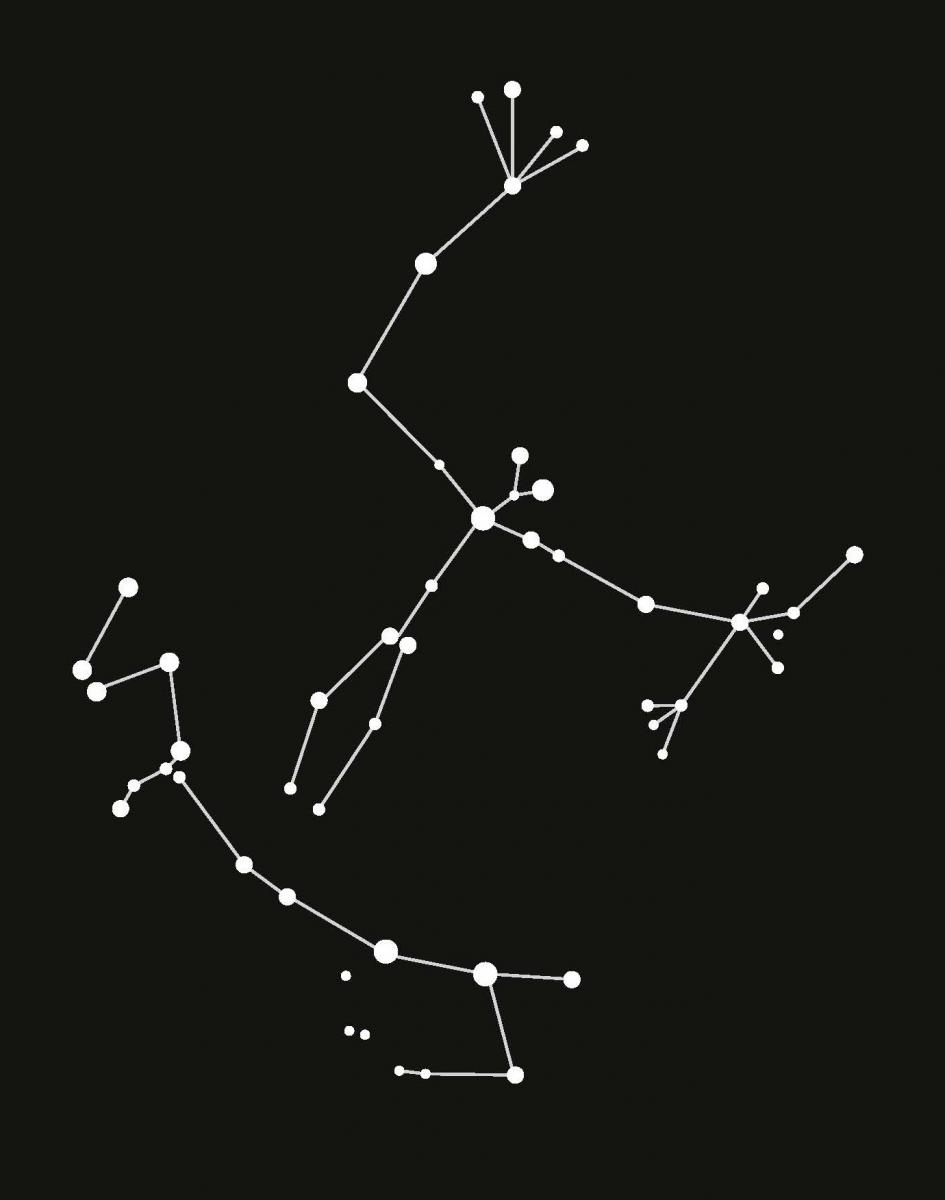
The Tagai constellation.
Culture
Flag
The Torres Strait Islander flag was designed by the late Uncle Bernard Namok of Thursday Island. The flag symbolises the unity and identity of all Torres Strait Islanders.
The flag is emblazoned with a white Dhari (head dress) which is a symbol of Torres Strait Islanders. The white five pointed star beneath it symbolises peace, the five major island groups and the navigational importance of stars to the seafaring people of the Torres Strait. The green stripes represent the land, the black stripes represent the people, and the blue represents the sea.
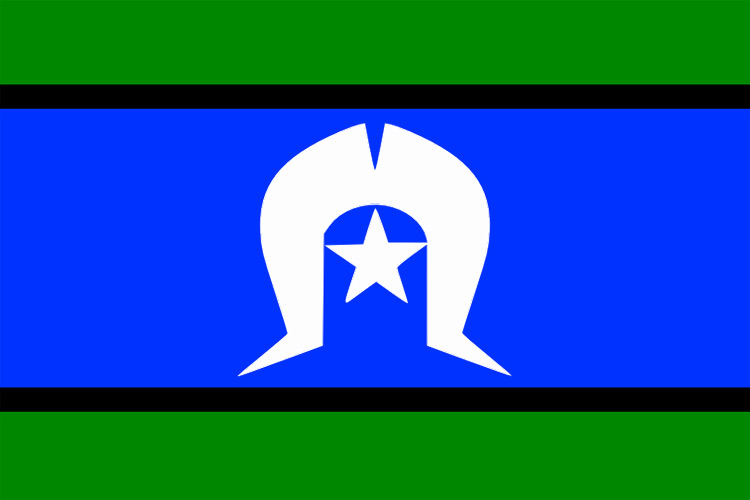
The Torres Strait Islander flag
Language
There are two language groups in the Torres Strait Islands; Miriam Mir and Kala Lagaw Ya.
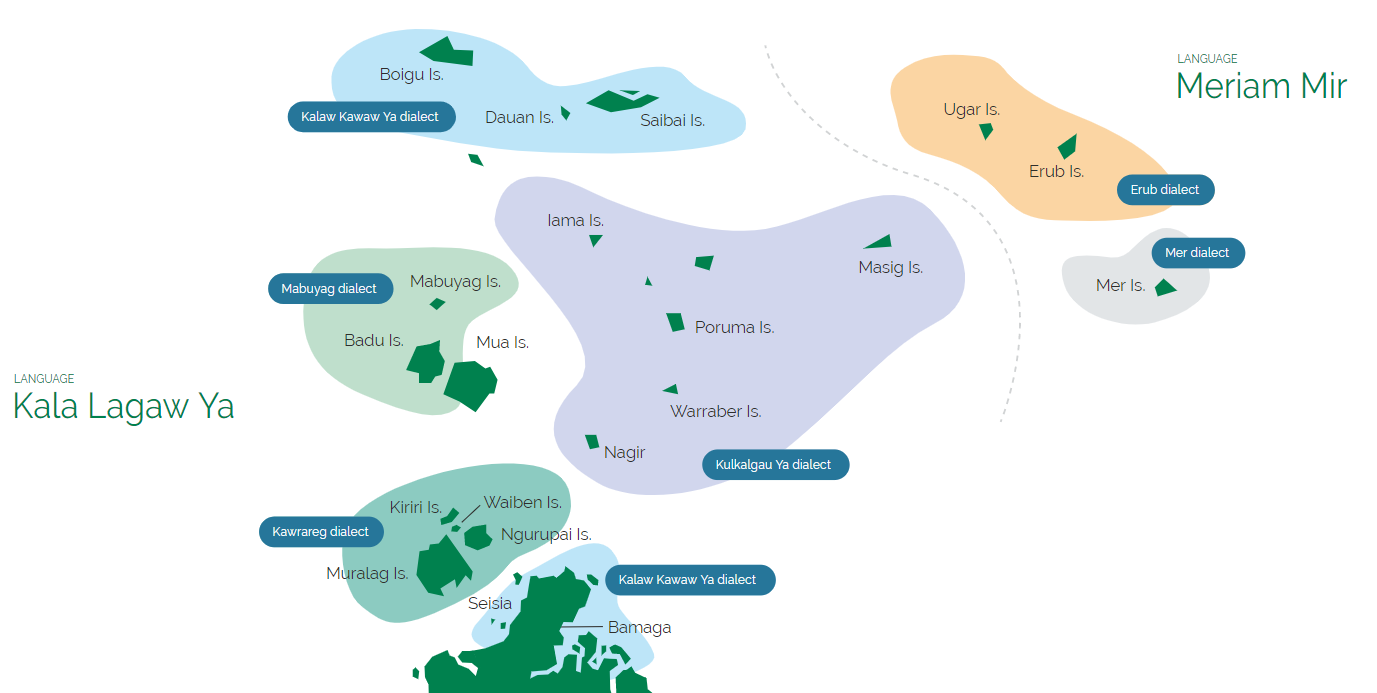
Language distribution across the Torres Strait Islands. Source: tstlanguages.org
Meriam Mir
The Meriam Mir language group (also written as ‘Miriam Mer’) is mainly spoken on the Eastern Islands of the Torres Strait and is closely related to Papuan languages. Meriam Mir is made up of two main regional dialects:
- Mer dialect – Mer, Waier, Daur.
- Erub dialect – Erub and Ugar
Gelam - A creation story about the formation of the islands of Mer, Waier and Dauar. Spoken and sung in the Mer dialect of the Meriam Mir language group. English subtitles are provided.
This video was sourced from Re-Told, The Myths and Legends of the Torres Strait - The State Library of Queensland
Kala Lagaw Ya
The Kala Lagaw Ya language group is mainly spoken on the Western and Central islands of the Torres Strait and more closely related to the Aboriginal languages of the continental mainland. Kala Lagaw Ya has four distinct regional dialects.
- Mabuyag – from Mabuiag, Badu and St. Paul’s Village
- Kalaw Kawaw Ya – from the top western islands of Saibai, Dauan and Malu Ki'ai
- Kawrareg – from the south western islands of Kubin, Kaiwalagal, Muralag (Prince of Wales), Nurupai (Horn), Giralag (Friday), Waiben (Thursday Island), Keriri (Hammond), Maurura (Wednesday), Moa (Banks). It is also known as Kawalgau Ya
- Kulkalgau Ya – from the central islands of Aurid (Aureed), Damut (Dalrymple), Iama (Yam or Turtle-backed), Masig (Yorke), Mauar (Rennel), Naghir (Mt Earnest), Poruma (Coconut) and Warraber (Sue).
Biw - A story explaining how the sea became salty. Spoken in the Kalaw Kawaw Ya dialect from the Kala Lagaw Ya language group.
This video was sourced from Re-Told, The Myths and Legends of the Torres Strait - The State Library of Queensland
Wameyal - A group of children's mischief lands them in trouble with their parents. Spoken in the Mabuyag dialect from the Kala Lagaw Ya language group.
This video was sourced from Re-Told, The Myths and Legends of the Torres Strait - The State Library of Queensland
Torres Strait Creole
The development of Torres Strait Creole (also known as Ailan Tok or Yumplatok) emerged through contact with the colonisers from the 1800s onwards. Composed of a mixture of standard Australian English and the local Torres Strait Islander languages, each island has its own locally based Creole.
Word List
The Torres Strait Islander people shared their culture and language orally. The language list below is only a guide as there are many variations in the spelling and pronunciation.
The sample word list below was sourced from the State Library of Queensland. For the full list and resource, scroll to the bottom of this page and download the attached document.
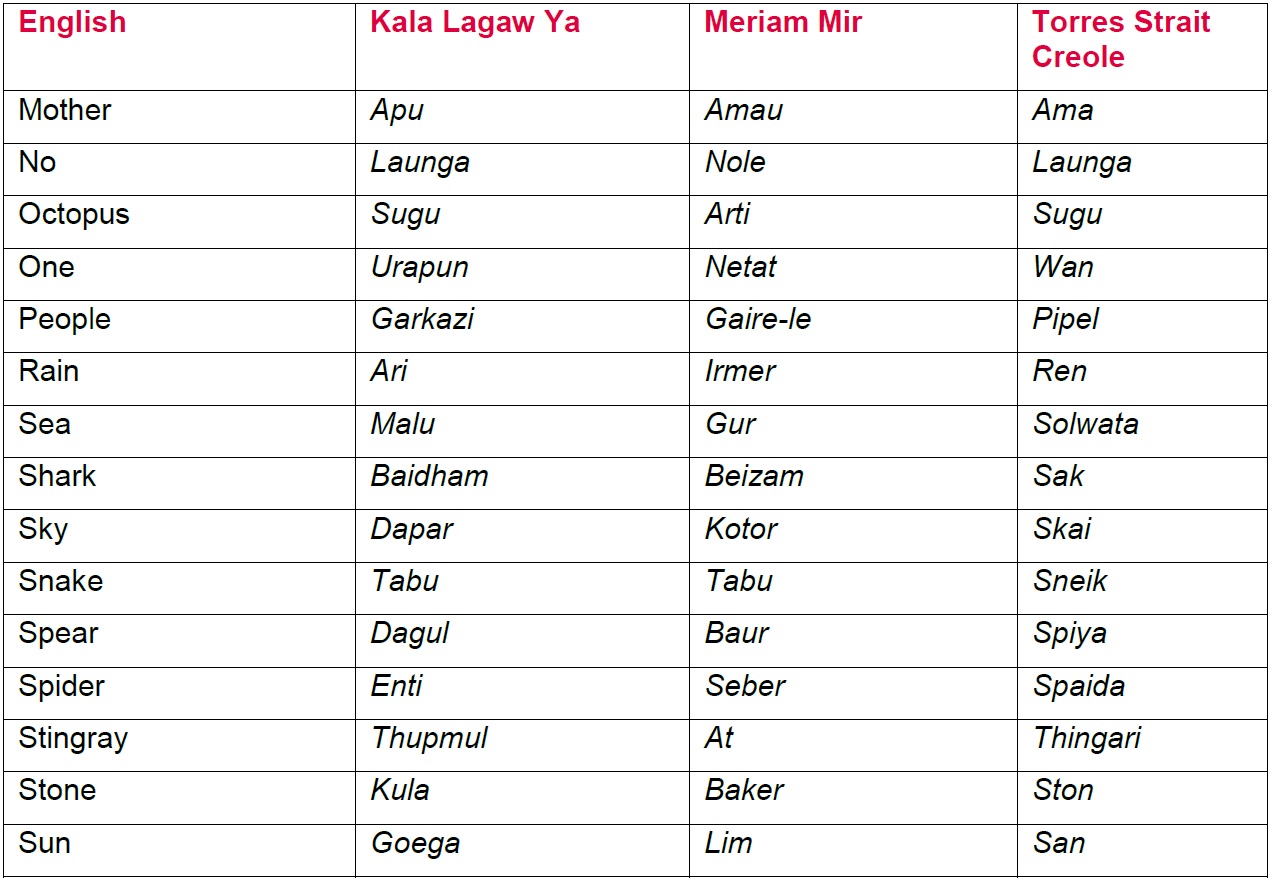

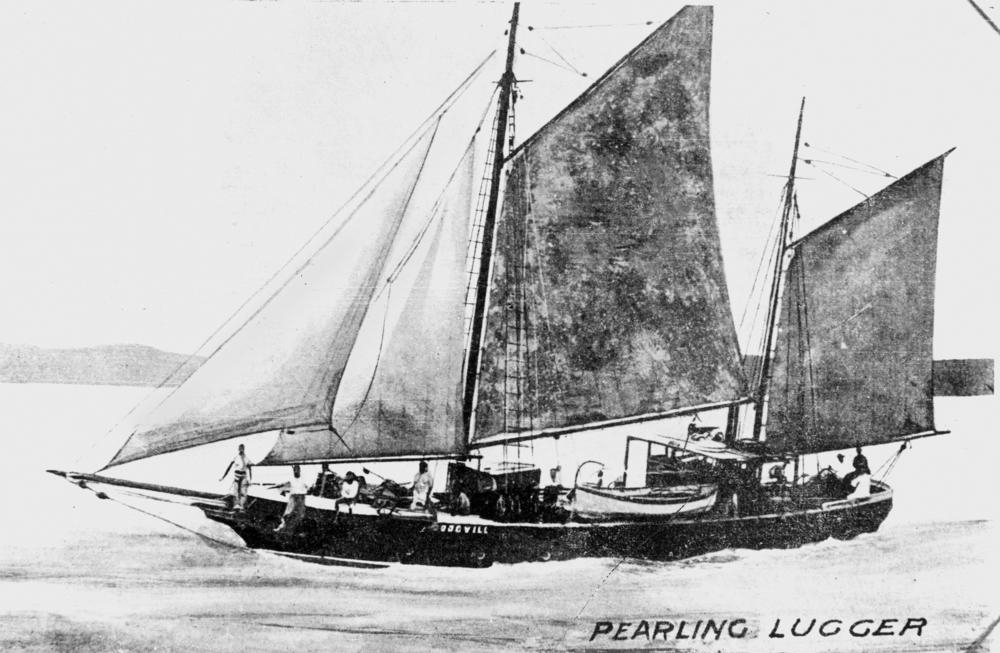
Pearling Luggers of the Torres Strait. Image Source: SLQ Today
Colonial history
Following invasion, the first colonial settlement was at Somerset, Cape York, in 1863, however it was moved to Port Kennedy on Waiben (Thursday Island) in 1877 and as a result Waiben has been the administrative and commercial ‘capital’ of Torres Strait.
Within the decade of colonists arriving, Torres Strait Islander society was changed forever by three important events. First, commercial quantities of pearlshell were discovered in 1870. Then in 1971 Christian missionaries and teachers arrived to the islands and finally all the islands were legally annexed to the Colony of Queensland by 1879.
Pearling
Pearling has had a long history in Australia. Long before colonisation, it was the shell that was the prized item being used for trade in everyday life. The shell would also have various artistic designs etched into it.
The pearling industry truly took hold during the 1870’s where over a 100 boats and luggers converged on the Torres Strait in search of pearl shells.
The pearling industry was dangerous work and many people died as result of their time on the luggers (boats). ‘Black-birding’ was also common practice. This was when Indigenous people (both from the mainland and neighbouring islands) were enslaved to work in the pearling industry.
Pearling as a practice declined during World War II where its luggers were taken by the Australian Navy and the Torres Strait Islands became an important strategic location, so the space available for diving greatly reduced.
Introduction of Christianity
Christian missionaries arrived in 1871 to Erub (Darnley Island) and two years later they opened the first Torres Strait school there.
Christianity impacted the structures that were already in place and many beliefs that merge Islander culture and Christianity are held.
Today, Christianity remains strong in Torres Strait Islander communities, and is celebrated in the Coming of the Light ceremony.

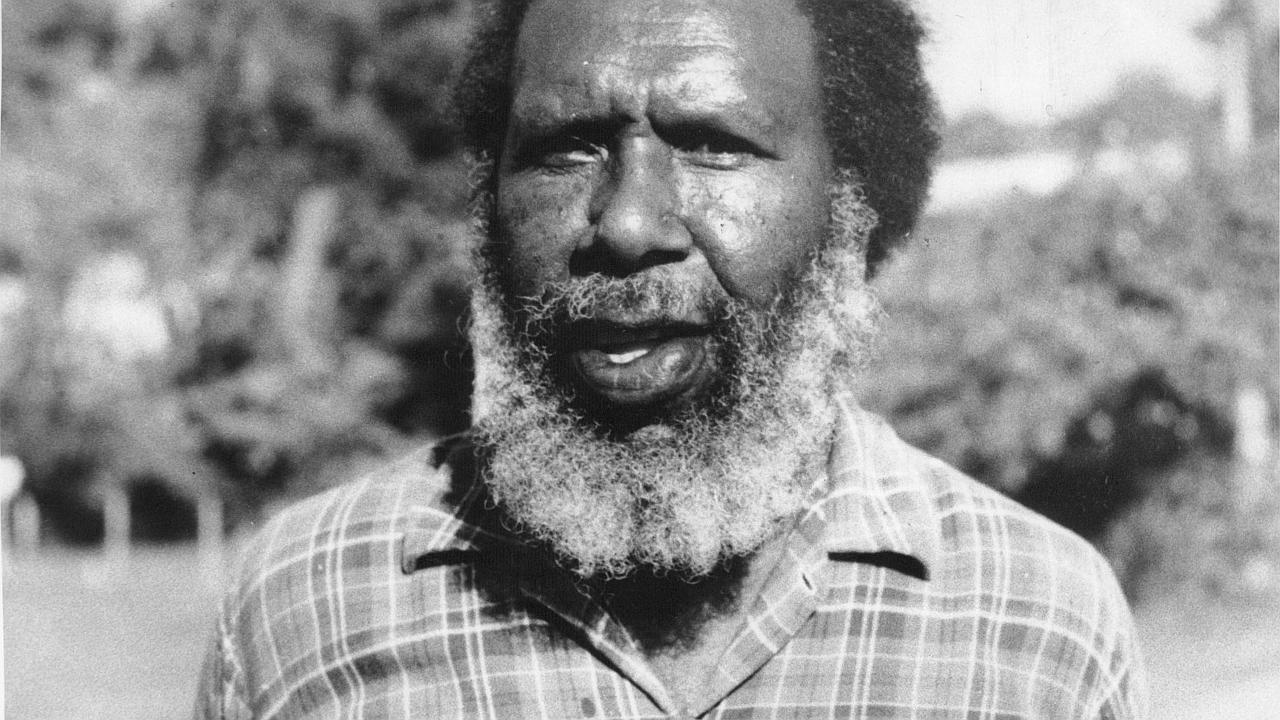
Uncle Eddie Mabo. Image Source: Young Workers
Leaders
Below are three people who have made important contributions to the Torres Strait Island's culture and politics.
Councillor Vonda Malone
Mayor Vonda Malone is a Torres Strait Islander woman born and raised on Thursday Island. With over 22 years experience working for the Australian Government, in 2016, she became the first female mayor of the Torres Shire Council.
A tireless advocate for her community, Mayor Malone has been involved has been involved in a number of ‘Closing the Gap’ initiatives in her community from health and housing, to employment, social services, economic development, legal and native title.
A work in community has been recognised and appreciated through her winning of the Centenary Medal and the NAIDOC Award of Excellence, and in 2018, in its first year, she won the Mackinnon Emerging Political Leader of the Year award.
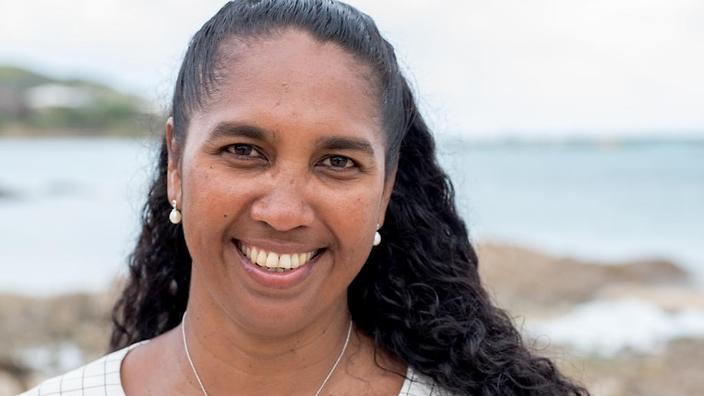
Vonda Malone. Image source: NITV
Uncle Ken Thaiday Sr. (1950 - )
Uncle Ken Thaiday Snr. was born in 1950 on Erub (Darnley) Island. He is an artist best known for this dance masks (or ‘dance machines’). He learnt his craft through his father who also played an important role within his community, preserving dance practices in ceremony and creating headdresses for cultural practice.
Uncle Ken continues to evolve his practice using materials such as modern plastics, plywood and paint in contemporary interpretations the traditional ‘dance mask’. His work commonly depicts local fish and bird, but he is best know for his Shark headdresses.
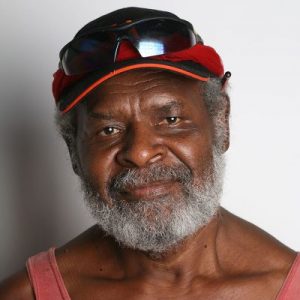
Uncle Ken Thaiday. Image Source: Australian Art Network.
Uncle Eddie Koiki Mabo (1936 - 1991)
Uncle Edward ‘Koiki’ Mabo was born in 1936, in Las on the island of Mer (Murray Island) in the Torres Strait
Uncle Koiki was involved in politics and community organising throughout his life. In 1982 Uncle Koiki, along with Islanders, Sam and David Passi, Celuia Mapo Salee, and James Rice lodged a claim for their land and began legal proceedings for his famous Court case. This case saw the first recognition of Aboriginal rights to land in the Australian legal system.
For more information about Uncle Koiki and his legacy you can check out the Mabo Case entry on our history timeline here.

Uncle Eddie Mabo. Image Source: National Museum Australia
Resources
- Anna Shnukal, Torres Strait Islanders
- Torres Strait Regional Authority
Sources
- National NAIDOC Committee, Because of her, we can! - Mayor Vonda Malone
- Torres Strait Regional Authority
- Duane Hamucher, The Conversation, A Shark In the Stars: Astronomy and Culture in the Torres Strait
- Queensland Curriculum and Assessment Authority, Spirituality and religion among Torres Strait Islanders
- ABC News, Reconciling the dark history of Australian pearling
- State Library of Queensland, Pearling Luggers of the Torres Strait
- Queensland Historical Atlas, Pearling
- ABC, Torres Strait lugger tells of South Sea Islander pearling
- Pearl Lugger Heritage Fleet, Pearling in Cape York and the Torres Strait
-
Torres Strait Islander Language Wordlist
Sample word lists made up from the the Meriam Mir, Kala Lagaw Ya and the Torres Strait Creole language groups. Sourced from the State Library of QueenslandDownload
-
Kala Kawaw Ya Language list
A word list from the Kalaw Kawaw Ya dialect from the Kala Lagaw Ya language group. Sourced from the State Library of Queensland.Download
